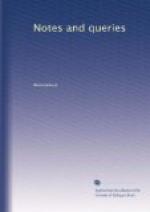A.W.
Brighton.
The Meaning of “Pallace.”—A lease granted by the corporation of Totness in Devon, in the year 1703, demises premises by this description: “All that cellar and the chambers over the same, and the little pallace and landing-place adjoining to the river Dart.” Can your readers give an explanation of the term “pallace?”
J.R. ROGERS.
Did Oliver Cromwell write “The New Star of the North?”—Perhaps some of your numerous correspondents, who have perused a curious letter of Count de Tessins, in Clements’ Bibliotheque Curieuse, tome ix. page 331., can inform me what credit, or if any, is due to the Count’s conjecture, that Oliver Cromwell was the author of the book entitled The New Star of the North, shining upon the victorious King of Sweden, &c. 4to. London, 1632.
J.M.
Oxford.
Meaning of Savegard and Russells.—In the will of Elizabeth Coddington, lady of the manor of Ixworth, 1571, mention is made of “the red russells quilt,” of “a felde bed,” and of “my cloke and savegard of freseadon.” I shall be obliged by any description of the garment known as the savegard, and of the russells quilt.
BURIENSIS.
Pandoxare.—Having met with an old volume containing the entire household expenses, as well as in some degree a diary, kept by a country gentleman during the reigns of James II., William and Mary, and Anne, I observed that he has made use of a species of hieroglyphics, to facilitate his reference to his book, as it contained all the entries of all kinds, in chronological order. For instance, where mention is made of money spent on behalf of one person in his house, he puts at the side of the page a clay pipe, rudely drawn; an entry of the payment of wages to another servant has a jug of ale; another a quill pen; another a couple of brooms, as the housemaid; a fiddle for the dancing master for his daughter; payment made to the sexton or parish-clerk has a representation of the village church by its side, and the window-tax a small lattice-window; and on the days that they brewed, a small barrel is drawn by the side of the date. And the chief object of my letter is with respect to this last; a barrel is often drawn, and by its side the words, primo relinitus, and the date, naturally meaning the day it was tapped; and then shortly after comes another barrel, and to it is written the word Pandox., or sometimes in full Pandoxavimus; in some places at the end of the year there is a list to this effect:—




